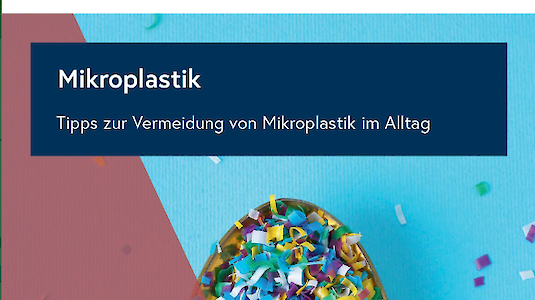Invisible but still dangerous - microplastics!
Plastics can be found in all areas of everyday life. A new brochure informs about the effects of microplastics on humans and nature and gives helpful tips on how to avoid them.
Nowadays, microplastics can be found everywhere in nature via various input pathways: in the oceans and rivers, in deep-sea sediments, in agricultural soils, on glaciers, in Arctic snowflakes and in various organisms. Microplastics can be orally ingested with food through the consumption of fish and seafood. In a study by the Federal Environment Agency and the Medical University of Vienna, microplastics were detected in human stool for the first time in 2018 - but the effects on humans are still unclear.
Avoiding microplastics in everyday life
So-called primary microplastics are intentionally added to products such as cosmetics, detergents or paints, which end up in the sewage system with the rinse water. Much more problematic are secondary microplastic particles, which are produced by tyre abrasion, fibre abrasion during textile washing or by the decomposition of e.g. packaging. Other entry pathways are e.g. artificial turf fields and releases at construction sites.
The Organisation for Scientific Co-operation and Development (OECD) reports that of the approximately 353 million tonnes of plastic waste generated annually (2019), only 9% is recycled and 19% is properly incinerated - the rest ends up in the environment and decomposes into smaller and smaller pieces. For this reason, the responsible use and disposal of plastics is crucial.
In order to reduce the release of microplastics into the environment, the Austrian Action Plan with a bundle of measures was drawn up under the auspices of the Federal Ministry for Climate Protection, Environment, Energy, Mobility, Innovation and Technology (BMK).
New Boschüre on microplastics
In this context, the Federal Ministry for Climate Protection, Environment, Energy, Mobility, Innovation and Technology has published the brochure Microplastics together with "die Umweltberatung". The brochure contains information on bioplastics, the effects of microplastics on humans, animals and the environment, as well as helpful tips on how to avoid microplastics according to different areas of life in everyday life. In addition, you will find the new regulatory measures at EU level at the end of the brochure.
You can order the brochure free of charge by e-mail at v5@bmk.gv.at or download it from the link https://www.bmk.gv.at/themen/klima_umwelt/kunststoffe/publikationen/mikroplastik.html
